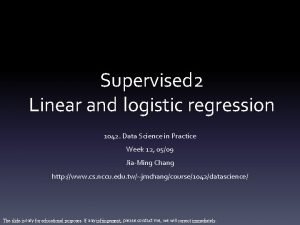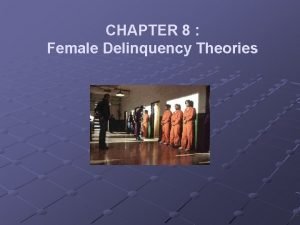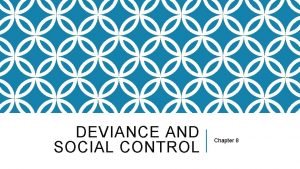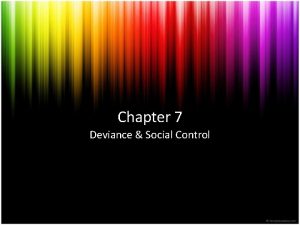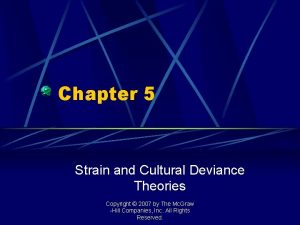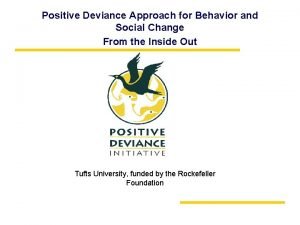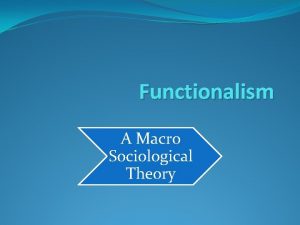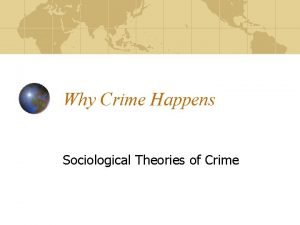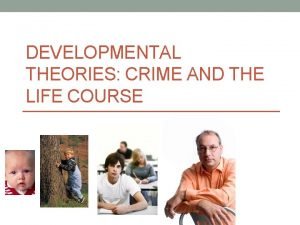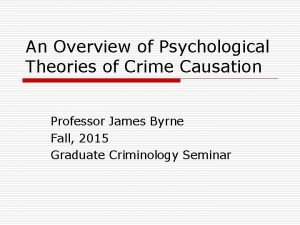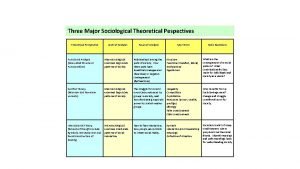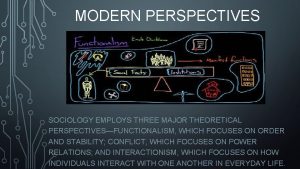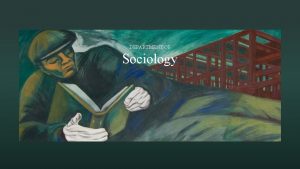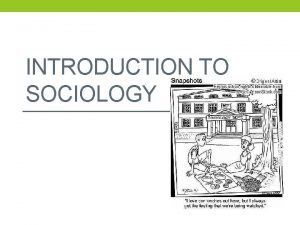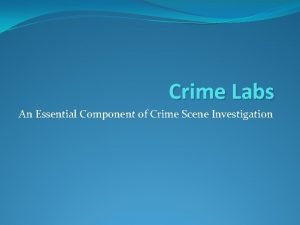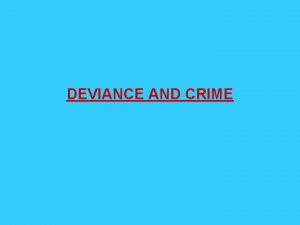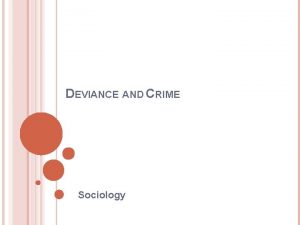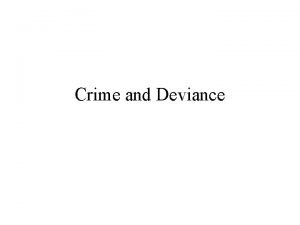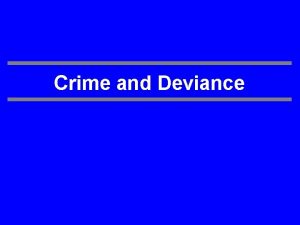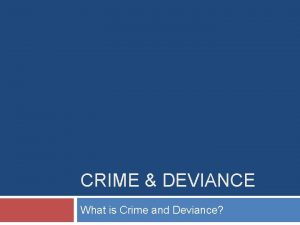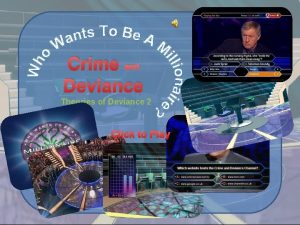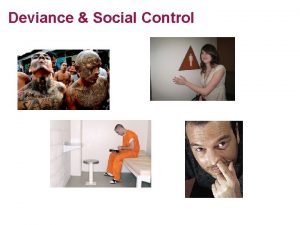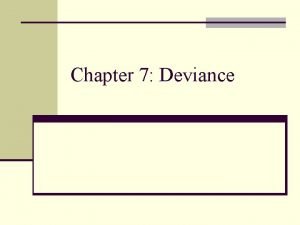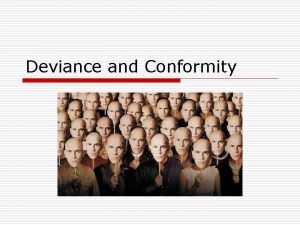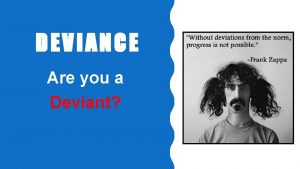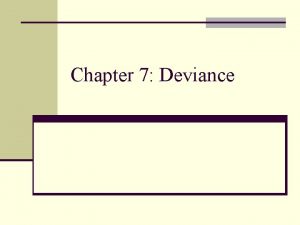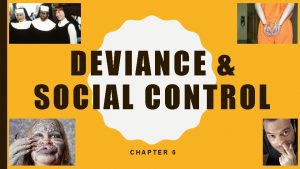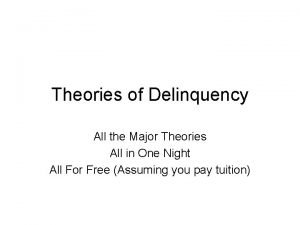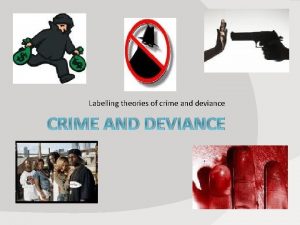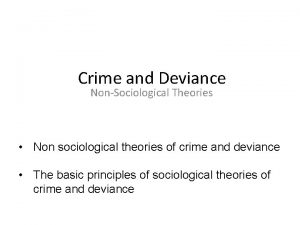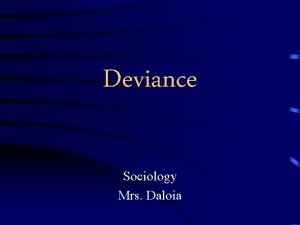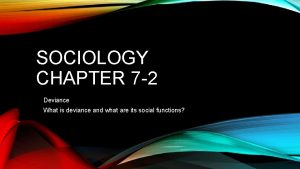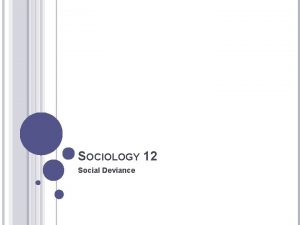Major Theories of Crime Delinquency Deviance Sociology Rules






















- Slides: 22

Major Theories of Crime, Delinquency, Deviance: Sociology Rules


I. CHICAGO SCHOOL/SOCIAL DISORGANIZATION/CULTURAL TRANSMISSION • THRASHER THE GANG (1927): studied 1, 313 gangs. Delinquent gangs were formed naturally during adolescence from spontaneous play groups. Group members were transformed into a gang by conflict with other groups and common enemies like the police. • SHAW AND MCKAY(1929, 1930, 1931, 1936, 1942): crime/delinquency was the highest in the low rent areas near the center of the city and in deteriorated neighborhoods. Later, they shifted away from social disorganization emphasis & adopted a cultural transmission perspective (i. e. , Play groups). • SUTHERLAND'S DIFFERENTIAL ASSOCIATION THEORY (1939): Criminal behavior is learned through the interaction with intimate interpersonal groups. A person becomes delinquent because of an excess of definitions favorable to the violation of law over definitions unfavorable to violation of law.

BIOGENIC / FREUDIAN THEORIES • Tend to be “single bullet” theories. e. g. XYY syndrome-XYY males were more violent, aggressive, taller & less intelligent Social/deviant behavior is too complex to be explained by a single linear model of causation. • Biosocial theories like Wilson and Herrnstein tend to “everything and the kitchen sink”- Wilson & Herrnstein Crime And Human Nature-argue that inherited constitutional factors influence the decision to commit crime. E. g. criminal tend to be mesomorphic, low iq, impulsive, extroverted etc. • Freudian theory of deviance is basically a mythical construction (i. e. , Id, Ego, Superego) based on a small amount of case studies and not based in empirical research. In fact, modern research has showed the chemical/biological origins of mental illness. Drugs are more effective in keeping mental illness in check than psychoanalysis.

SUTHERLAND'S DIFFERENTIAL ASSOCIATION THEORY 1. Criminal behavior is learned. 2. Criminal behavior is learned in interaction with other persons in a process of communication. 3. The principal part of learning of criminal behavior occurs within intimate personal groups. 4. When criminal behavior is learned, the learning includes(1) techniques of committing the crime, which are sometimes very complicated, sometimes very simple; and (2) the specific direction of motives, drives, rationalizations, and Attitudes. 5. The specific direction of motives and drives is learned from definitions of the legal codes as favorable or unfavorable. 6. A person becomes delinquent because of an excess of definitions favorable to the violation of law over definitions unfavorable to violation of law. 7. Differential associations may vary in frequency, duration, priority, and intensity. The process of learning criminal behavior by association with criminal and anticriminal patterns involves all the mechanisms that are involved in any other learning. 8. The process of learning criminal behavior by association with criminal and anticriminal patterns involves all of the mechanisms that are involved in any other learning. 9. While criminal behavior is an expression of general needs and values, it is not explained by those general needs and values, since noncriminal behavior is an expression of the same needs and values.

SOCIAL STRUCTURAL MERTON (1938) ANOMIE THEORY: Modern society is anomic. Deviance/crime is a result of the disjunction between cultural goals and institutionalized means. Deviance/crime is a result of societal strain and blocked legitimate opportunities. e. g. Innovation, retreatism, rebellion. .

MERTON (1938) ANOMIE THEORY: CULTURAL GOALS INSTITUTIONALIZED MEANS CONFORMITY + + INNOVATION + - RITUALISM - + RETREATISM - - -/+ REBELLION

Subcultural/gang Theories • COHEN DELINQUENT BOYS (1955): Combined self role theory with anomie theory. Delinquency is a result of status frustration of lower class boys who find themselves disadvantaged in trying to compete in a middle class setting such as school. Gang subculture is a reaction formation against or a rejection of middle class values. • CLOWARD & OHLIN (1960) DIFFERENTIAL OPPORTUNITY THEORY: Combined Differential Assn. of Sutherland with Merton's anomie. Delinquency arises when legitimate means are blocked and illegitimate means are accessible. Three types of delinquent subcultures: Conflict (fighting), criminal (theft) & drug taking (retreatist-double failures). • MILLER (1958): Delinquency is result of lower class culture's focal concerns (trouble, toughness, smartness, excitement, fate, autonomy) & female headed households.

Renegade Kids, Suburban Outlaws • Wooden and Blazak Renegade Kids, Suburban Outlaws: From Youth Culture to Delinquency ( 2001) distinguish between renegade kids( stylistic rebellion by basically "good kids“) from outlaws (serious delinquents). • Borrow Cohen's notion that subcultures are problem solvers. Updated Cohen's typology: Corner boy---Mall rats, punkers, and metalers College boy---preppies and conformists Delinquent boy---Taggers, skinheads, stoners, and Satanists. The banality, boredom, and normlessness of suburbia pushes middle class kids into subcultures.

Drift-Neutralization Theory Matza & Sykes Techniques of Neutralization (1957) and Matza Delinquency and Drift (1964) A) This is a subculture of delinquency in the United States, but the subculture is not limited to young people. B) American culture is a mixture of conventional norms and subterranean deviant tradition. 1) Those traditions have a complex relationship to law, which is symbiotic rather than oppositional. 2) Deviant traditions make up a part of the overall culture that consists of the personal, less conventional, and less publicized standards of behavior. 3) The two sets of traditions--conventional and deviant--are held simultaneously by almost everyone, and although certain groups may be influenced more by one than the other, both affect behavior to a considerable degree. 4) A delinquent subculture, rather than being found only among youths, has its roots in the broader culture. C) Soft Determinism: Delinquency is situational. CLASSICAL CRIMINOLOGY----SOFT DETERMINISM----POSITIVISM FREE WILL SOME CHOICE BEHAVIOR DETERMINED 1) Delinquency is a product of social interaction. 2) To understand the behavior of young people, it is necessary to recognize that they exist in a condition of drift between criminal and conventional action. 3) Matza saw human behavior as emerging from a continuous process of interaction. a) Adolescents have a modicum of choice in deciding whether to violate the law. b) That choice will be determined not by some prior set of causes but by factors present in the situation where the choice is made--who is present, what the risks are, etc. c) Nobody has or is compelled to commit delinquent behavior. Nobody is delinquent 24/7. 4) Whether a youth breaks the law will depend on a process that is influenced more be immediate circumstance than by conditions that are predetermined by personality, social position, or membership in a deviant subculture.

Drift-Neutralization Theory D) Techniques of neutralization 1) Defined = verbal statements that serve to lessen the impact of, if not justify, the commission of delinquency. 2) Neutralization precedes commission of a delinquent act, or it can occur after the delinquency. 3) Five techniques of neutralization: 1) Denial of responsibility. 2) Denial of the victim. 3) Denial of injury. 4) Condemn the condemners. 5) Appeal to a higher loyalty. Major criticism: The theory is merely descriptive not causal.

Conflict theory III. CONFLICT THEORY/INTEREST GROUP --pluralist model of power--competing interest groups. Solution: reform A. TURK Criminality and Legal Order (1969): Criminalization is an assignment of criminal status to people through norm-enforcement mechanisms of arrest and trial. B. Quinney Social Reality of Crime (1970): Crime is a construct/social definition. The social reality of crime is constructed by the formulation and application of criminal definitions, the development of behavior patterns related to criminal definitions, and the construction of criminal conceptions.

Marxist RADICAL MARXIST CRIMINOLOGY • Crime is defined: 1 -as a violation of human rights or offense against the working class. , 2 -result of the structured inequality, 3 -ruling class imposing its notion of reality on the powerless classes. • Blame: the capitalist system (state-centered model of power). Solution: Revolution. QUINNEY CRITIQUE OF THE LEGAL ORDER (1974): America is an advanced capitalist society. • The state is organized to serve the interests of the ruling class. Criminal law maintains social inequality. • Ruling class dominates by coercion and violence. He called for replacement of capitalism by socialism. • Class, State and Crime (1977): Crime is an adaptative response of the surplus population of workers.

Marxist (continued) • PEACE AND SOCIAL JUSTICE PERSPECTIVE--QUINNEY AND WILDEMAN (1991) QUINNEY AND PEPINSKY (1991): Define crime as a violation of human rights. The criminal justice system is founded on violence and assumes that violence can be overcome by violence. In order to overcome this, criminology should be based on nonviolence, compassion, love and forgiveness. • LEFT REALISM/BRITISH REALISM (MATTHEWS AND YOUNG 1986; YOUNG, 1988): Strives to reconcile radical theory with realistic social policy. Predatory crime is a significant social problem for the working class. Propose short-term anticrime strategies, that both challenge right wing law and order campaigns and take seriously the working class's "well founded fear" of street crime, such as democratic control of policing, community participation in crime prevention and policy development.

Labeling (social reaction) • Labeling theorists were concerned with societal reactions to delinquency. • Labeling theorists tend to be symbolic interactionists. The labeling approach has its theoretical roots in symbolic interactionist such as George Herbert Mead, Charles Horton Cooley and W. I. Thomas. Mead stressed the role of "significant others" , "generalized other", and role playing in the development of children. Cooley observed that an individual's self-evaluation and self-identity are basically a reflection of one's perception of other people's reactions to his or her conduct which he called the Looking-Glass Self. W. I. Thomas (1931) contributed the concept of Definition of the Situation which essentially means that when people define a situation as real, it becomes real in its consequences. • Their assumptions about human nature and social order are generally the same as those of symbolic interactionists with a twist. Assume that human nature is relatively flexible and subject to change. • Far more concerned with the stigmatizing effects of arrest and adjudication on lawbreakers than on the processes of interaction that produce their illegal behavior in the first place. • Labeling theorists are inclined to believe that lawbreakers are relatively normal people. If they persist in delinquent behavior and become serious offenders, it is due less to their own evil nature than to the negative ways in which police, judges, and correctional authorities react to their behavior.

Labeling (social reaction) The assumptions of labeling theorists about social order reflect this same bias. 1) The acknowledge that society is characterized by cultural conflict. 2) They suggest that this conflict is usually resolved in favor of people in positions of power and influence. 3) Thus, the definition and imposition of social rules will reflect their interests, not those of powerful groups. 4) Delinquent characteristics are not an inherent property of individuals, but rather, a property that is conferred on them by others--by legal officials and those who have the power to legislate their own brand of morality. 5) Children become delinquent not because of their behavior or some sort of predisposition to crime, but because they are labeled as delinquents by persons in positions of power.

The Dramatization of Evil -Tannenbaum (1938) A) Tannenbaum argued that the last step in the making of serious delinquent occur not when a child violates the law, but when he or she becomes enmeshed in the juvenile justice system. B) All children engage in minor violations that they consider to be fun, play, of interest, excitement, etc. 1) Adults perceive of the violations as nuisance, evils, and delinquency. Such acts often result in chastisement, juvenile court action, and punishment. C) To the extent that these acts continue, and to the extent that the different perceptions of them persist, two things will happen: 1) Adults’ view will harden. Soon, their tendency to view specific acts as evil will be transformed into a tendency to view mischievous children as evil. 2) A view of mischievous children as evil will leave a lasting and destructive effect. These children will come to believe that they are different from other children. a) They will have acquired new, delinquent self-images from the negative reactions to them. D) This process is the dramatization of evil and will become a self-fulfilling prophecy. E) The relatives of mischievous children, the police, juvenile court and correctional officials are often enthusiastic and well-intentioned in their efforts to reform them, but their very enthusiasm defeats their objective. 1) As long as they are defined as bad and isolated from conventional groups and activities, their only resource is to join other children like themselves--who also have been defined as bad. 2) It is when this occurs that truly serious problems begin to emerge. 3) Delinquent gangs develop that provide the only source of security for labeled children. 4) Gangs begin to generate their own norms.

Primary and Secondary Deviation (Lemert, 1951) A) Primary deviance. 1) Defined: Deviance that is neither detected nor punished by anyone in authority. 2) Such deviance is common and can be due to a variety of causes. 3) Until primary deviance is detected, there are no delinquents. 4) Since their reputations have not been destroyed by labeling, they will tend to retain a conformist self-concept and avoid the negative consequences of being viewed as evil persons. 5) If, however, their primary deviance is detected, the results may resemble those described by Tannenbaum. The evil will be dramatized and the status of the offenders will be transformed. 6) Once people are labeled, they are expected to adhere to an addition set of official rules that apply only to them. But rather than helping to reduce their problems, those new rules only increase them. B) Secondary deviance. 1) Evolves from the adaptations that labeled persons make to the problems created by reactions to their primary deviance. 2) The product of a rather long process--primary deviance, punitive reactions, further deviance, more punitive reactions, until eventually children accept their deviant status and become full-fledged delinquents.

Social Creation of Delinquency. • In his book, The Outsiders (1963), Becker propounded the view that deviance, like beauty, exists in the eye of the beholder. No act is intrinsically deviant (e. g. smoking pot), but must be defined as such. Deviance is behavior that people so label. • SOCIAL GROUPS CREATE DEVIANCE BY MAKING RULES WHOSE INFRACTION CONSTITUTES DEVIANCE. (p. 9) • OUTSIDERS REFERS TO THOSE PEOPLE WHO ARE JUDGED TO BE DEVIANT AND THUS OUTSIDE THE CIRCLE OF “NORMAL” MEMBERS OF THE GROUP (P. 15) • Deviance as a master status. • LABELING IS A POLITICAL PROCESS. The most powerful control “outsiders” by labeling them. Adults make the rules for teenagers. WASPs makes the rules for immigrants. Middle class make the rules for lower class. • Moral entrepreneurs--people who become crusaders--are the ones most likely to seek the new rules by which new forms of deviance are created. They are disturbed by some evil and will not be content until it is corrected.


Classification of major sociological approaches to the analysis of deviance Perspective (definition of deviance) and level of analysis Normative perspective (deviance as norm violation) Characteristics of approaches Relativistic perspective (deviance as audience definition) Macro level of analysis Micro level of analysis Macro-normative Micro-normative Macro-relativistic Micro-relativistic 2. Example of theory using approach Anomie theory Differential association theory Conflict theory Labeling theory 3. Central theoretical goal Explain societal rates of deviant behavior Explain deviant behavior of individuals Understand societal sources of definitions of deviance Understand individual implications of reactions to deviance 4. Nature and focus of concepts Large-scale environmental variables Small-scale environmental variables Large-scale conflict processes Small-scale interactional processes 5. Typical sources of data Secondary data; probability sample survey data; cross-national data Sample survey data; case studies Historical documents; secondary data Field observation and ethnographic research Scientific, "value free" Activist, "value engaged" Humanistic, "value engaged" 1. Descriptive term for approach 6. Value orientation James D. Orcutt, Analyzing Deviance, Dorsey Press, 1983.

Food for thought • Should a good theory of deviance be able to explain conformity?
 Crime and deviance sociology revision
Crime and deviance sociology revision Logistic regression residual deviance
Logistic regression residual deviance Female delinquency theories
Female delinquency theories Sociology chapter 8 deviance and social control
Sociology chapter 8 deviance and social control Examples of deviance in society
Examples of deviance in society Cultural deviance
Cultural deviance Positive deviance sociology definition
Positive deviance sociology definition Chapter 7 deviance crime and social control
Chapter 7 deviance crime and social control Difference between crime and deviance
Difference between crime and deviance Crime and deviance definition
Crime and deviance definition Marxism crime and deviance
Marxism crime and deviance Anomie and strain theories
Anomie and strain theories How does sociology interpret hate crimes
How does sociology interpret hate crimes Is functionalism a macro theory
Is functionalism a macro theory Sociological theory of crime
Sociological theory of crime Modern biological theories of crime
Modern biological theories of crime Theories of human development
Theories of human development Psychological theory of crime causation
Psychological theory of crime causation Theoretical perspectives in sociology
Theoretical perspectives in sociology Three major theoretical perspectives in sociology
Three major theoretical perspectives in sociology Dartmouth sociology
Dartmouth sociology Sociology is the scientific study of
Sociology is the scientific study of 4 major federal crime labs
4 major federal crime labs

